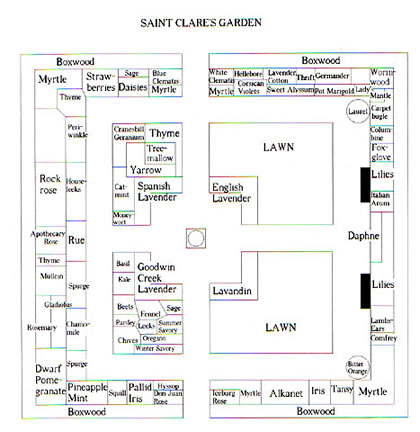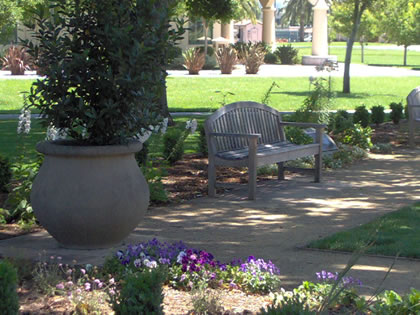
Layout of St. Clare Garden (PDF)
Alphabetical List of Plants in the St. Clare Garden (PDF)
St. Clare’s Garden contains plants known to have been cultivated in Central Italy in the 13th century. It is based in part upon Albert the Great’s description of a pleasure garden in his De vegetabilibus et plantis (1260) (see below).
The garden is enclosed by low boxwood shrubs. Paths of fine decomposed granite lead visitors through the garden. Arched trellises carrying roses or clematis enframe the two entrances to the garden.

A shady section of the garden contains ornamental plants grown in honor of the Virgin Mary, such as Lady’s Mantle. This medieval devotion of dedicating part of a garden to Mary was practiced by religious women such as St. Clare, who sought to emulate the purity and virginity of Mary. Another section of the garden contains plants and herbs that were a major part of Clare and her sisters’ diet, such as kale, basil, chard, onion chives, and parsley, which was the favorite vegetable of St. Francis.
Medicinal herbs commonly found in medieval gardens such as rue, wormwood, and mint are in another section of the garden. In the small central plaza of the garden stands a granite basin carved by Indigenous Ohlone Indians during the Mission Period, surrounded by four varieties of lavender.
Common Italian wildflowers such as cranesbill geranium and yarrow are in another section of the garden. Simple benches on one side of the garden provide a resting place for visitors.
St. Albert the Great, De vegetabilibus et plantis
“There are, however, some places of no great utility or fruitfulness but designed for pleasure…They are in fact mainly designed for the delight of two senses, namely sight and smell. They are therefore provided rather by removing what especially requires cultivation: for the sight is in no way so pleasantly refreshed as by fine and close grass kept short….
Care must be taken that the lawn is of such a size that about it in a square may be planted every sweet-smelling herb such as rue, and sage and basil, and likewise all sorts of flowers, as the violet, columbine, lily, rose, iris and the like. So that between these herbs and the turf, at the edge of the lawn set square, let there be a higher bench of turf flowering and lovely; and somewhere in the middle provide seats so that men may sit down there to take their repose pleasurably when their senses need refreshment. Upon the lawn too, against the heat of the sun, trees should be planted or vines trained, so that the lawn may have a delightful and cooling shade, sheltered by their leaves….let them be sweet trees, with perfumed flowers and agreeable shade, like grapevines, pears, apples, pomegranates, sweet bay trees, cypresses, and such like.
Behind the lawn there may be great diversity of medicinal and scented herbs, not only to delight the sense of smell by their perfume but to refresh the sight with the variety of their flowers, and to cause admiration at their many forms in those who look at them. Let rue be set in many places between them, for the beauty of its green foliage and also that its biting quality may drive away noxious vermin from the garden. There should not be any trees in the middle of the lawn, but rather let its surface delight in the open air, for the air itself is then more health-giving. If the [midst of the] lawn were to have trees planted on it, spider’s webs stretched from branch to branch would interrupt and entangle the faces of the passers-by.
If possible a clear fountain of water in a stone basin should be in the midst, for its purity gives much pleasure…. It is then delight rather than fruit that is looked for in the pleasure garden.” (Translation by John Harvey, Mediaeval Gardens, London, 1981, p.6)
This web site was written and designed by Nancy Lucid whose research was supported by a generous grant from the Bannan Institute for Jesuit Educational Mission at Santa Clara University.
For questions regarding the web site contact Nancy Lucid. All rights reserved.